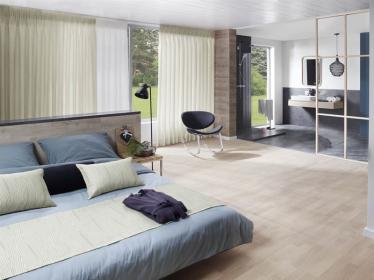Grüne Ausrichtung bestätigt: Schmitz Textiles mit Bestnoten ausgezeichnet
- Emsdettener Textilhersteller nach STeP by OEKO-Tex® für nachhaltige Produktion zertifiziert
Nachhaltigkeit ist das Schlagwort der Stunde – auch in der Wirtschaft. Eine nachhaltige Welt erfordert jedoch eine neue Art des Wirtschaftens zum Schutz der Ressourcen und Umwelt. Das Textilunternehmen Schmitz Textiles, zu dem die Marke drapilux gehört, hat es sich zur Aufgabe gemacht, in jedem Produktionsbereich so grün wie möglich zu handeln. Das Engagement wurde nun durch die erfolgreiche Zertifizierung nach STeP by OEKO-TEX® belohnt.
STeP (Sustainable Textile Production) by OEKO-TEX® ist ein unabhängiges Zertifizierungssystem für Marken, Handelsunternehmen und Hersteller im Bereich der Textilindustrie. OEKO-TEX®, ein Zusammenschluss von 18 unabhängigen Prüf- und Forschungsinstituten für Textil- und Lederökologie aus Europa und Japan, entwickelt Standards für die Textil- und Lederindustrie sowie die zugrundeliegenden Prüfmethoden und Grenzwerte. Ziel ist es, ein Risikomanagement, den Verbraucher- und Umweltschutz sowie gesetzliche Konformität sicherzustellen. Neben dem Aspekt der Umweltfreundlichkeit untersucht STeP nachhaltige Produktionsbedingungen, den effizienten Einsatz von Ressourcen und Technologien sowie die Einhaltung von sozialverträglichen Arbeitsbedingungen. Die Prüfung umfasst sechs Module: Chemikalienmanagement, Umweltleistungen, Umweltmanagement, Soziale Verantwortung, Qualitätsmanagement sowie Gesundheitsschutz und Arbeitssicherheit. Die Zertifizierung ist ein starkes Instrument zur kontinuierlichen Optimierung der Nutzung natürlicher Ressourcen und zeigt Wege auf, Prozesse effizienter zu gestalten. Durch die Transparenz und weltweite Vergleichbarkeit der Kriterien unterstützt STeP Endverbraucher und Händler bei der Auswahl des Textilherstellers. Schmitz Textiles kann so seinen Vorbildcharakter in allen Bereichen noch weiter stärken. „Nachhaltigkeit war schon immer ein wichtiges Thema bei Schmitz Textiles“, bekräftigt Stefan Ruholl, Geschäftsführer des Emsdettener Unternehmens. So hat der Textilhersteller bereits 2002 die ISO 14001 Norm implementiert, die die Anforderungen an ein Umweltmanagementsystem festlegt. „Die Zertifizierung nach STeP krönt unser Engagement noch einmal, da die Anforderungen über die gesetzlichen hinaus gehen und zum Beispiel Einsatzverbote für gewisse Gefahrenstoffe mit sich bringen“, führt Stefan Ruholl aus.
Auch in Zukunft will das Emsdettener Unternehmen mit gutem Beispiel vorangehen. „Getreu dem Motto der Gründerfamilie Schmitz ‚Der Zukunft verpflichtet – schon immer‘ werden wir uns bis zum nächsten Audit in drei Jahren noch weiter verbessern“, verspricht Stefan Ruholl. drapilux-Vertriebsleiter Hubert Reinermann ergänzt, dass auch die Produkte nachhaltiger werden sollen. So hat drapilux 2020 als erste der Schmitz Textiles-Marken Artikel mit einem Anteil an nachhaltig produzierten Fasern präsentiert. Gemeinsam mit dem Garnhersteller Trevira arbeitet drapilux daran, das neuartige Garn weiterzuentwickeln und den Anteil des recycelten Materials zu erhöhen.
schönknecht : kommunikation
gesellschaft für public relations und marketing mbh







